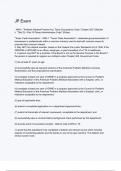JP Exam
- ANS-i. "Podiatric Medical Practice Act, Texas Occupations Code, Chapter 202" (Statute)
ii. "Title 22—Part 18 Texas Administrative Code" (Rules)
"Texas Trade Association" - ANS-1. "Texas Trade Association"—statewide group/association of
businesses or professionals within a common industry used to deal with common issues &
promote their common interest
2. May NOT be a Board member, based on the Federal Fair Labor Standards Act of 1938, if the
PERSON or SPOUSE is an officer, employee, or paid consultant of a TTA in healthcare
3. A person may NOT be a member of the Board or act as the General Counsel to the Board if
the person is required to register as a lobbyist under Chapter 305, Government Code
(1) be at least 21 years of age;
(2) successfully pass all required sections of the American Podiatric Medical Licensing
Examination and the jurisprudence examination;
(3) complete at least one year of GPME in a program approved by the Council on Podiatric
Medical Education of the American Podiatric Medical Association with a hospital, clinic, or
institution acceptable to the department;
(4) complete at least one year of GPME in a program approved by the Council on Podiatric
Medical Education of the American Podiatric Medical Association with a hospital, clinic, or
institution acceptable to the department;
(5) pay all applicable fees;
(6) submit a completed application on a department-approved form;
(7) submit all transcripts of relevant coursework, acceptable to the department; and
(8) successfully pass a criminal history background check performed by the department;
(9) provide proof of successful complet - ANS-to hold a DPM in TX
(1) proof that the practitioner has completed a didactic and clinical course which includes
aspects of monitoring patients and the hands-on use of the gas machine. The didactic and
clinical course must:
,(A) be directed by a licensed and certified M.D., D.O., D.D.S., or D.P.M., in the State of Texas
with advanced educational and clinical experience with routine administration of nitrous
oxide/oxygen inhalation conscious sedation;
(B) include a minimum of four (4) hours didactic work in pharmacodynamics of nitrous
oxide/oxygen inhalation conscious sedation; and
(C) include a minimum of six (6) hours of clinical experience under personal supervision; and
(2) proof that the practitioner has completed a continuing medical education course in nitrous
oxide/oxygen inhalation conscious sedation that includes training in the prevention and
management of emergencies in the podiatric medical practice; and
(3) proof that - ANS-To use nitrous oxide/oxygen inhalation conscious sedation on a patient for
podiatric medical purpose in the State of Texas, the practitioner must first register with the
department and provide the following:
(1) The department shall select for audit a random sample of license holders to ensure
compliance with CME hours.
(2) If selected for an audit, the license holder shall submit copies of certificates, transcripts or
other documentation satisfactory to the department, verifying the license holder's attendance,
participation and completion of the continuing education.
(3) Failure to timely furnish this information within thirty (30) calendar days or providing false
information during the audit process or the renewal process are grounds for disciplinary action
against the license holder.
(4) If selected for continuing education audit during the renewal period, the license holder may
renew and pay renewal fees. - ANS-CPME audits
(4) "Podiatry" means the treatment of or offer to treat any disease, disorder, physical injury,
deformity, or ailment of the human foot by any system or method. The term includes podiatric
medicine.
(b) In the laws of this state:
(1) "chiropody" means podiatry; and
(2) "chiropodist" means podiatrist. - ANS-under this chapter to practice podiatry and who directly
or indirectly charges money or other compensation for podiatric services; or
, (B) publicly professes or claims to be a podiatrist, foot specialist, or doctor or uses any title,
degree, letter, syllable, or word that would lead the public to believe that the person is a
practitioner authorized to practice or assume the duties incident to the practice of podiatry.
(b) A person who receives information under Subsection (a)(3) may not directly or indirectly
identify the patient in any report of the research, audit, or evaluation or otherwise disclose the
patient's identity.
(c) Records reflecting charges and specific services provided may be disclosed only when
necessary to collect fees for services provided by a podiatrist, professional association, or
another entity qualified to provide or arrange for services.
(d) Records created by a state hospital, a state school, or an employee of the state hospital or
state school that are otherwise confidential under this subchapter may be disclosed in an official
legislative inquiry regarding the state hospital or state school. Information or records that identify
a patient or client may not be released for any purpose unless proper consent to the release is
given by the patient. - ANS-o, and a podiatrist may disclose information made confidential under
this subchapter to:
(1) a government agency, if:
(A) the disclosure is required or permitted by law; and
(B) the agency protects the identity of a patient whose podiatric records are examined;
(2) medical or law enforcement personnel, if the podiatrist determines that there is a probability
of:
(A) imminent physical injury to the patient, the podiatrist, or another person; or
(B) immediate mental or emotional injury to the patient;
(3) qualified personnel for a management audit, financial audit, program evaluation, or research;
(4) a person who presents the written consent of the patient or a person authorized to act on the
patient's behalf for the release of confidential information, as provided by Section 202.406;
(5) an individual, corporation, or governmental entity involved in the payment or collection of
fees for services provided by
(f) Each certifying board that is not recognized by the Council on Podiatric Medical Education of
the American Podiatric Medical Association must meet each of the following requirements: -
ANS-(1) the certifying board requires all practitioners who are seeking certification to
successfully pass a written or an oral examination or both, which tests the applicant's




